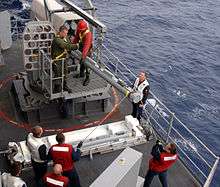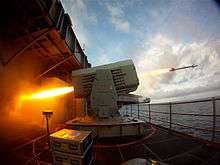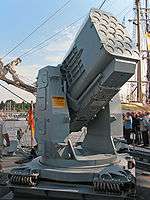RIM-116 Rolling Airframe Missile
The RIM-116 Rolling Airframe Missile (RAM) is a small, lightweight, infrared homing surface-to-air missile in use by the German, Japanese, Greek, Turkish, South Korean, Saudi Arabian, Egyptian, Mexican and U.S. Navies. It was intended originally and used primarily as a point-defense weapon against antiship cruise missiles. The missile is so named because it rolls around its longitudinal axis to stabilize its flight path, much like a bullet fired from a rifled barrel. As of 2005, it is the only U.S. Navy missile to operate in this manner.[2]
| RIM-116 Rolling Airframe Missile | |
|---|---|
_launches_RIM-116_missile_2013.jpg) A RIM-116 being launched from USS New Orleans in 2013. | |
| Type | Close-in weapons system |
| Place of origin | Germany and United States |
| Service history | |
| In service | 1992–present |
| Used by | See operators |
| Production history | |
| Designer | General Dynamics (now Raytheon) / Diehl BGT Defence |
| Designed | 1976 |
| Manufacturer | General Dynamics (now Raytheon) / Diehl BGT Defence |
| Unit cost | US$998,000 (FY2014)[1] |
| Produced | 1985–present |
| Variants | See variants |
| Specifications | |
| Mass | 5,777 kg (12,736 lb) (launcher) 73.5 kilograms (162 lb 1 oz) (missile) |
| Length | 2.79 m (9 ft 2 in) (missile) |
| Warhead | blast fragmentation warhead |
| Warhead weight | 11.3 kg (24 lb 15 oz) |
| Engine | Hercules/Bermite Mk. 36 Solid-fuel rocket |
| Wingspan | 434 mm (17.1 in) |
| Propellant | solid |
Operational range | 10 km (6.2 mi) |
| Maximum speed | In excess of Mach 2 (1,522 mph; 2,450 km/h) |
Guidance system | three modes—passive radio frequency/infrared homing, infrared only, or infrared dual mode enabled (radio frequency and infrared homing) |
| Accuracy | over 95% |
Launch platform | Mk 144 Guided Missile Launcher (GML) of the Mk 49 Guided Missile Launching System (GMLS) |
The Rolling Airframe Missiles, together with the Mk 49 Guided Missile Launching System (GMLS) and support equipment, make up the RAM Mk 31 Guided Missile Weapon System (GMWS). The Mk-144 Guided Missile Launcher (GML) unit weighs 5,777 kilograms (12,736 lb) and stores 21 missiles. The original weapon cannot employ its own sensors prior to firing so it must be integrated with a ship's combat system, which directs the launcher at targets. On U.S. ships it is integrated with the AN/SWY-2 Ship Defense Surface Missile System (SDSMS) and Ship Self-Defense System (SSDS) Mk 1 or Mk 2 based combat systems. SeaRAM, a launcher variant equipped with independent sensors derived from the Vulcan Phalanx CIWS, is being installed on Littoral Combat Ships and certain Arleigh Burke-class destroyers.
Development
The RIM-116 was developed by General Dynamics Pomona and Valley Systems divisions under a July 1976 agreement with Denmark and West Germany (the General Dynamics missile business was later acquired by Hughes Aircraft and is today part of Raytheon). Denmark dropped out of the program, but the US Navy joined in as the major partner. The Mk 49 launcher was evaluated on board the destroyer USS David R. Ray in the late 1980s.[2] The first 30 missiles were built in FY85 and they became operational on 14 November 1992, on board USS Peleliu.
Service
The RIM-116 is in service on several American and 30 German warships. All new German Navy warships will be equipped with the RAM, such as the new Braunschweig-class corvettes, which will mount two RAM launchers per ship. The Greek Navy has equipped the new Super Vita–class fast attack craft with the RAM. South Korea has signed license-production contracts for their navy's KDX-II, KDX-III, and Dokdo-class amphibious assault ship.[3]
US Navy
The U.S. Navy plans to purchase a total of about 1,600 RAMs and 115 launchers to equip 74 ships. The missile is currently active aboard Gerald R. Ford-class aircraft carriers, Nimitz-class aircraft carriers, Wasp-class amphibious assault ships, San Antonio-class amphibious transport dock ships, Whidbey Island-class dock landing ship, Harpers Ferry-class dock landing ships, and littoral combat ships (LCS).[4]
Variants


Block 0
The original version of the missile, called Block 0, was based on the AIM-9 Sidewinder air-to-air missile, whose rocket motor, fuze, and warhead were used. Block 0 missiles were designed to initially home in on radiation emitted from a target (such as the active radar of an incoming antiship missile), switching to an infrared seeker derived from that of the FIM-92 Stinger missile for terminal guidance. In test firings, the Block 0 missiles achieved hit rates of over 95%.
Block 1
The Block 1 (RIM-116B) is an improved version of the RAM missile that adds an overall infrared-only guidance system that enables it to intercept missiles that are not emitting any radar signals. The Block 0's radar homing capabilities have been retained.
Block 2
The RAM Block 2 is an upgraded version of the RAM missile aimed at more effectively countering more maneuverable antiship missiles through a four-axis independent control actuator system, increased rocket motor capability, an improved passive radio frequency seeker and upgraded components of the infrared seeker, and advanced kinematics.[5] On 8 May 2007, the US Navy awarded Raytheon Missile Systems a $105 million development contract; development was expected to be completed by December 2010. LRIP began in 2012.[6] 51 missiles were initially ordered. On 22 October 2012, the RAM Block 2 completed its third guided test vehicle flight, firing two missiles in a salvo and directly hitting the target, to verify the system's command and control capabilities, kinematic performance, guidance system, and airframe capabilities. Raytheon was scheduled to deliver 25 Block 2 missiles during the program's integrated testing phase.[7][8] The Block 2 RAM was delivered to the U.S. Navy in August 2014,[9] with 502 missiles to be acquired from 2015 to 2019.[10] Initial Operational Capability (IOC) for the Block 2 RAM was achieved on 15 May 2015.[11]
In early 2018 the U.S. State Department approved the sale of RIM-116 Block II to the Mexican Navy for use on their future Sigma-class design frigates, the first of which was jointly built by Damen Schelde Naval Shipbuilding and launched in November 2018. [12] [13]
HAS mode
In 1998, a memorandum of understanding was signed by the defense departments of Germany and the United States to improve the system, so that it could also engage so-called "HAS", Helicopter, Aircraft, and Surface targets. As developed, the HAS upgrade just required software modifications that can be applied to all Block 1 RAM missiles.
SeaRAM weapon system

The SeaRAM combines the radar and electrooptical system[2] of the Phalanx CIWS Mk-15 Block 1B (CRDC) with an 11-cell RAM launcher to produce an autonomous system—one which does not need any external information to engage threats. Like the Phalanx, SeaRAM can be fitted to any class of ship. In 2008, the first SeaRAM system was delivered to be installed on USS Independence.[14] As of December 2013, one SeaRAM is fitted to each Independence-class vessel. In late 2014, the Navy revealed it had chosen to install the SeaRAM on its Small Surface Combatant LCS follow-on ships.[16] Beginning in November 2015, the Navy will complete installation of a SeaRAM on the first of four Arleigh Burke-class destroyers patrolling within the U.S. 6th Fleet.[17] The SeaRAM will equip the Royal Saudi Navy's multi-mission surface combat (MMSC) based on the Freedom-class littoral combat ships.[18]
General characteristics (Block 1)
- Primary function: Surface-to-air missile
- Contractor: Raytheon, Diehl BGT Defence
- Length: 2.79 m (9 ft 2 in)
- Diameter: 127 mm (5.0 in)
- Fin span: 434 mm (1 ft 5.1 in)
- Speed: Mach 2.0+
- Warhead: 11.3 kg (24.9 lb) blast fragmentation
- Launch weight: 73.5 kg (162 lb)
- Range: 10 km (6.2 mi)
- Guidance system: three modes—passive radio frequency/infrared homing, infrared only, or infrared dual-mode enabled (radio frequency and infrared homing)
- Unit cost: $998,000
- Date deployed: 1992
Operators
Current operators












_fires_a_surface-to-air_intercept_missile_from_the_Rolling_Airframe_Missile_(RAM)_launcher_during_Combat_System_Ship_Qualification_Trials_off_t.jpg) A Rolling Airframe Missile fired from USS Green Bay
A Rolling Airframe Missile fired from USS Green Bay RAM Launcher on fast attack craft Ozelot of the German Navy.
RAM Launcher on fast attack craft Ozelot of the German Navy.
See also
References
- Notes
- "United States Department Of Defense Fiscal Year 2015 Budget Request Program Acquisition Cost By Weapon System" (pdf). Office Of The Under Secretary Of Defense (Comptroller)/ Chief Financial Officer. March 2014. p. 63.
- Norman Polmar (2005). Ships and Aircraft of the U.S. Fleet. The Naval Institute. p. 519.
- "PGM—Precision Guided Munitions". LigNex1.com. Archived from the original on 27 September 2015. Retrieved 31 October 2014.
- U.S. Navy (17 March 2012). "Enterprise Sailors onload a RAM launcher" – via YouTube.
- "Navy Declares IOC On Rolling Airframe Missile Block 2". News.USNI.org, 11 June 2015
- "Raytheon's RAM Strikes Twice During Back-to-Back Tests." Raytheon, 39 January 2012.
- "RAM Block 2 Missile Successful in Double-fire Test". Deagel.com, 22 October 2012
- "Rolling Airframe Missile Block 2 completes initial fleet firing". 12 August 2013.
- "Raytheon delivers first Block 2 Rolling Airframe Missiles to US Navy". Raytheon press release, 27 August 2014
- "Navy to Accept New Rolling Airframe Missile". DoDBuzz.com, 19 May 2014
- "US Navy Declares Initial Operational Capability for New Rolling Airframe Missile RAM Block 2". Navyrecognition.com, 16 May 2015
- "US approves sale of missiles, torpedoes and ammunition to Mexico for new Dutch-built naval vessel". 8 January 2018.
- http://www.defense-aerospace.com/articles-view/release/3/197876/mexican-navy-launches-opv-%E2%80%9Creformador%E2%80%9D.html
- "Raytheon Company has delivered its SeaRAM antiship missile defense weapon system for installation aboard the littoral combat ship USS Independence (LCS-2)" (Press release). Raytheon. Archived from the original on 6 June 2011. Retrieved 15 September 2010.
- "Hagel Approves Navy's Proposal to Build More Lethal LCS Variant". Military.com, 11 December 2014
- "Navy Integrating SeaRAM on Rota-Based DDGs; First Installation Complete in November". News.USNI.org, 15 September 2015.
- "US OKs Potential $11.25B Saudi Deal for LCS Variant". Defensenews.com, 20 October 2015
- "SeaRAM, Close-In Weapon System—Japanese Example Ship". military-today.com. Retrieved 13 August 2013.
- Chin, Jeremy (28 January 2019). "Germany Approves Sale of RAM to Qatar". CSIS Missile Threat. Archived from the original on 2 February 2019. Retrieved 2 February 2019.
- Bibliography
- Norman, Polmar (15 January 2005). The Naval Institute Guide to the Ships and Aircraft of the U.S. Fleet (Hardcover, 18th ed.). Annapolis, Maryland: Naval Institute Press. p. 519. ISBN 978-1-59114-685-8.
External links
| Wikimedia Commons has media related to RIM-116 Rolling Airframe Missile. |